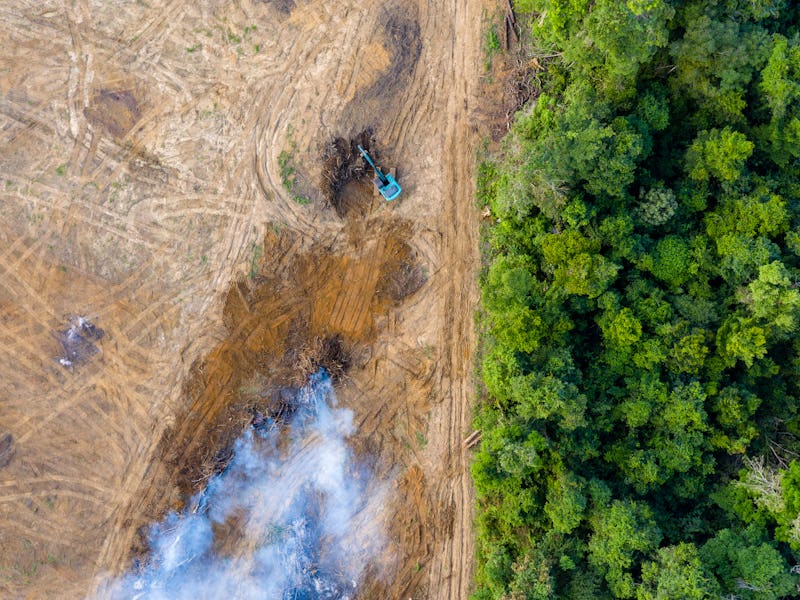Amazon deforestation is linked to the rise of a disease without a vaccine
Cutting down trees in the vast rainforest also increases malaria rates.

Illegal logging and pervasive wildfires are just a couple of the dangers facing the Amazon rainforest, a global bed of biodiversity and carbon sequestration. The consequences of this deforestation are as local as rising temperatures in Brazil and as distant as blooms of Sargassum seaweed in the Virgin Islands. Now scientists say we should add malaria to that list.
As deforestation in the Amazon increases, so do the rates of the mosquito-borne disease, shows a study published Monday in the journal Proceedings of the National Academy of Sciences. The burden of dealing with malaria, on the other hand, can decrease deforestation, posing a complex two-way relationship.
“The key implication is that forest clearing has a direct impact on human health, in addition to the loss of other ecosystem services such as species diversity, water quality, and carbon storage,” write the researchers Andrew MacDonald, Ph.D., assistant researcher at the University of California, Santa Barbara’s Earth Research Institute, and Erin Mordecai, Ph.D., assistant professor of biology at Stanford University.
The Amazon Rainforest is a global hotspot of biodiversity, and deforestation is disrupting its balance.
Loss of Amazon land has been a persistent issue in Brazil. The rate at which Brazil has lost Amazonian forest rose by 60 percent since 2014. Lately, Brazil’s President Jair Bolsonaro has come under international fire for dismantling environmental regulations in the rainforest.
While previous research has looked at the effects of forest clearing on malaria on local levels, the new paper analyzes 795 municipalities in the Brazilian Amazon to give a bigger picture. The study authors looked at malaria reports in those areas between 2003 and 2015, comparing it against global forest change data.
MacDonald and Mordecai found that increasing deforestation by 10 percent was associated with a 3.27 percent increase in malaria cases. The effect is greatest in the early stages of land development. Cleared trees create more forest edge, a habitat where mosquitoes can breed, thrive, and have a good chance of encountering humans to bite.
As forest loss persists, its effects on malaria scale down. At a certain point, human settlements become larger and further removed from forest, reducing opportunities for mosquitoes to infect people.
Deforestation and malaria seem to have a relationship, but it's complicated.
To really understand that correlation, the researchers say, it’s important to understand another, opposing relationship: As malaria rates increase, deforestation rates actually slow down. As malaria cases increase by one percent, there is a 1.4 percent drop in cleared forest area.
The study doesn’t dig into the underlying reasons that this happens, but the authors note that malaria “clearly and consistently” reduces economic activity, migration, and settlement, in turn potentially bringing down rates of tree clearing.
Failing to account for that reverse relationship could cause scientists to underestimate the true effect of deforestation on malaria, the researchers say, which “may have confounded the results of earlier studies.”
The new findings can be used to inform policy around forest conservation, land use, and public health in the Amazon. Reducing deforestation in the Amazon, and thereby keeping the ecosystem intact, “may have dual benefits for conservation and health,” the authors write.
Curbing land clearing in “pre-frontier” regions — those that have not yet been well developed — seems to be particularly crucial to these efforts.
“However, the impact of alternative livelihoods to deforestation and subsequent agricultural activities on conservation and health should also be considered in such a policy context,” the authors write.
Abstract: Deforestation and land use change are among the most pressing anthropogenic environmental impacts. In Brazil, a resurgence of malaria in recent decades paralleled rapid deforestation and settlement in the Amazon basin, yet evidence of a deforestation-driven increase in malaria remains equivocal. We hypothesize an underlying cause of this ambiguity is that deforestation and malaria influence each other in bidirectional causal relationships—deforestation increases malaria through ecological mechanisms and malaria reduces deforestation through socioeconomic mechanisms—and that the strength of these relationships depends on the stage of land use transformation. We test these hypotheses with a large geospatial dataset encompassing 795 municipalities across 13 y (2003 to 2015) and show deforestation has a strong positive effect on malaria incidence. Our results suggest a 10% increase in deforestation leads to a 3.3% increase in malaria incidence (∼9,980 additional cases associated with 1,567 additional km2 lost in 2008, the study midpoint, Amazon-wide). The effect is larger in the interior and absent in outer Amazonian states where little forest remains. However, this strong effect is only detectable after controlling for a feedback of malaria burden on forest loss, whereby increased malaria burden significantly reduces forest clearing, possibly mediated by human behavior or economic development. We estimate a 1% increase in malaria incidence results in a 1.4% decrease in forest area cleared (∼219 fewer km2 cleared associated with 3,024 additional cases in 2008). This bidirectional socioecological feedback between deforestation and malaria, which attenuates as land use intensifies, illustrates the intimate ties between environmental change and human health.